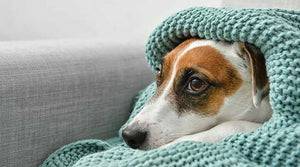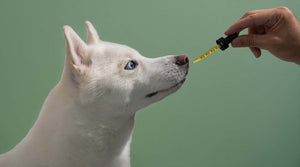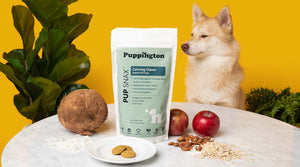Your Cart is Empty
FREE SHIPPING SITEWIDE!! | TAKE THE QUIZ & SAVE 15%
FREE SHIPPING SITEWIDE!! | TAKE THE QUIZ & SAVE 15%
FREE SHIPPING SITEWIDE!! | TAKE THE QUIZ & SAVE 15%
April 04, 2023 11 min read
As pup parents, none of us like leaving our dogs alone for too long. One of the most heart-wrenching sights is looking back at your dog’s big old puppy eyes as they watch you walk out the door! But it’s not just us pup parents that separation affects--many dogs also struggle with being separated from their humans. Sometimes, these feelings can lead to excessive nervousness; this is called separation anxiety. In fact, according to the University of Illinois College of Veterinary Medicine, between 20 and 40% of dogs experience separation anxiety!
This very well could include your pup. Read on to learn more about the causes of separation anxiety, how to tell if your dog has separation anxiety, and our best tips to prevent or minimize your dog’s separation anxiety.
What is separation anxiety?
Separation anxiety is a form of stress experienced by a dog when separated from their humans. Most of the time, this anxiety develops from the time the dog is left alone to when they reunite with their human. Separation anxiety can be mild or severe, depending on the symptoms exhibited.
Several factors trigger dog separation anxiety. Don’t feel bad if you haven’t thought of these; it’s easy for pet parents to miss triggers, as some are not obvious without prior knowledge.
A dog can develop separation anxiety due to:
It is no secret that dogs grow attached to their humans (and we, to them!) If dogs are close with their first human and experience a change, they may become afraid that the same thing will happen again if they are left alone. This is common in adopted dogs who have had different human caregivers previously.
Dogs are territorial and love to stick to one place for their entire lives. If a dog is getting everything they need in their current environment, they’ll see no reason to leave. A sudden shift from the current habitat, like when their human or family moves houses or cities or starting at a new daycare, may distress the dog.
Ignoring your dog can easily trigger separation anxiety. While dogs like some Dobermans can thrive on independence, other breeds like the Chihuahua may get devastated if they feel neglected by their human.
Remember all dogs are different though - there are some very clingy, needy Dobermans as well! Honor how much attention your own dog needs to thrive and be happy! A dog that feels neglected can develop a bad habit in a bid to get more attention from their human.
For dogs, a traumatic event could be anything from being left alone for too long or being confined to a shelter with limited human contact. Dogs who have experienced trauma sometimes relive this past trauma if they feel as though their human has abandoned them.
Dogs can get attached to more than one family member. When that member moves or passes away, dogs immediately feel the absence. Dogs who miss their family members may be restless as they wonder where one of their favorite humans went.
Though it is important to understand how separation anxiety develops, the most crucial part of soothing a pup’s anxiety is actually discovering that it’s happening! Most dog separation anxiety symptoms happen between the time the dog is left alone and when their human is back. Because of this, early signs of anxiety can be hard to catch, especially if it's only you and your dog living together.
Early signs of separation anxiety in dogs include:
Urinating or defecating
If a dog decides to go potty where they are not supposed to, it could be a sign of anxiety. When a dog urinates or defecates away from their designated area, it is often either a sign of rebellion or stress. Dogs who experience stress may be unable to hold their bladder. Other dogs may become angry or frustrated when they are left alone and might urinate or defecate as a sign of rebellion.
Also, under extreme stress, a dog may engage in a strange habit known as Coprophagia. Coprophagia happens when the dog defecates and proceeds to consume its own poo (gross, we know. But some do it!) Coprophagia is one of the hidden causes of halitosis or bad breath in dogs. See our article ondog mouth odor here, because separation anxiety is not the only cause of Coprophagia. Know that pups can be trained to stop this behavior.
Destructive chewing or digging
Some anxious dogs chew on furniture, clothing, or hard surfaces. Other dogs dig up holes in the yard. There are many reasons these behaviors arise, including boredom, loneliness, frustration, or panic. Each of these emotions can come up when a dog feels abandoned.
Pacing restlessly
Pacing around for no reason can also be a sign of separation anxiety in dogs. The dog may walk to and from in a straight line or circles, usually near the door. When under a lot of stress, the dog may also dig or chew things along their pacing route.
Escaping or trying to escape
Separation anxiety can cause a dog to try to run away from home. The dog may want to chase after their human, or they may feel too scared to remain in the house alone. If a dog succeeds, escaping could result in accidental self-harm, especially when the dog is trying to squeeze through tight spaces.
Separation anxiety is definitely a difficult thing to manage for both pups and pup parents, but it’s manageable with the right training techniques. The following dog calming techniques are easy to employ and often work very well in mildly anxious dogs.
Tips to keep in mind:
Start with a training crate.
A pet crate is a great way to teach your dog independence. For dogs with separation anxiety, the crate is likely to make them nervous at first; they may not like the feeling of not being able to go to you. To acclimate them to the crate, leave your dog in the pet crate for short periods as you go about your business in the house. You can be in one room while the dog is in an adjacent one.
Leave your pup in the crate alone for about five minutes. When they start to appear restless, show up and reassure them with a treat or favorite toy. As they grow more comfortable, you can gradually increase the time intervals. As you are doing this training, it’s important to remain within reach in case anything goes wrong. When your dog grows comfortable in the crate, it means they are learning to be independent!
Repeat this training until your pup can spontaneously chill in the crate without your supervision. Besides teaching independence to your dog, a pet crate can become a haven for some anxious pups!
Exercise your dog
Exercise can improve mood, release pent-up energy, and calm anxious pups. Before leaving, try taking your dog out for a brisk walk or engage them in some form of fun exercise in the house. It could even be a game of fetch or tug of war. The goal of exercise is to ensure your dog is tired and ready to rest after the exercise.
As your dog settles down to rest, reward them with food, water, and their favorite toy. This will keep your dog busy as you prepare to leave the house.
Show affection before leaving.
Try bidding your goodbyes before leaving the house. This may help your anxious pup feel less abandoned when you do have to leave. You could do this by sitting down with your dog for a brief bonding session. You could use this time to lightly groom your dog and check for minor problems like dry skin ordry, cracked paws. A third option is enticing your dog to their crate using a favorite toy, treat, or food. Be careful not to make too big of a deal about leaving, though-- you don’t want to alarm your pup!
Teach the “place” command
The place command is a vital training technique for teaching a dog to control their impulses and to respect your authority as their leader. The goal of this command is to teach your dog that lying calmly in a designated place will be rewarded. Learning impulse control helps to reduce panic and reactivity in stressful situations.
Pup parent tip: Stay tuned - we’ll cover how to train place in our upcoming blog series.
Do not leave abruptly
As you prepare to leave, keep things calm by not talking, touching, or maintaining eye contact with your dog. Doing this will instinctively help your dog ignore you as they continue to enjoy their quality time in the crate. It also lets your dog know that being independent from one another is normal.
When your dog comes rushing after noticing you at the door, use the “place” command to keep them still. Reward them with a treat for their obedience. Now, start moving towards the door while they stay in “place.” If you succeed in teaching “place,” it will help your dog to learn to control their impulse to get nervous and act out when they see you leaving.
The above training techniques often work in addressing mild separation anxiety in dogs, but some pups experience a more severe type of anxiety that can be harder to treat on your own. Severely anxious dogs that show aggression or other destructive behaviors are usually harder to train. You may have to employ the services of a behavioral specialist to help train your dog. If you have tried training your pup on your own and have not been able to make progress, it is definitely worth engaging a professional.
Also, consider hiring a professional trainer if your dog does not respect your authority. Dogs instinctively follow one leader, the alpha. If your dog does not see you as alpha, hiring a trainer can help you learn how to establish your authority in a healthy but firm way.
Another situation that calls for a professional dog trainer is when you do not personally have the patience or time to train your dog. We love our pups, but sometimes training them is just too much for us to handle alone, or our lives are too busy to do it all by ourselves. Dogs can be a handful, especially if you are dealing with a particularly strong-willed breed like the Beagle or Poodle. A professional dog trainer can help if you do not have the time or skill to correctly train your dog.
Proper nutrition can alleviate separation anxiety in dogs. Though adjusting your dog's diet will not completely cure their anxiety, it can be very helpful, especially when used in conjunction with other techniques like training.
Vitamins, minerals, and essential oils you can use to calm anxious dogs include:
Vitamin A for dogs helps in boosting the immune system. A fortified immune system improves a dog's ability to fight infections and diseases. In addition, vitamin A helps in the normal functioning of neurotransmitters which promotes a healthy brain function. It is one of the necessary vitamins for holistic canine health, which decreases incidences of anxiety.
Vitamin E is a natural antioxidant for dogs. It improves cognitive function by maintaining healthy brain cells. Vitamin E is also essential for strengthening muscles, improving the functions of internal organs like the heart, and maintaining healthy skin in dogs.
B Vitamins
Vitamins B1, B6, and B12 are necessary for promoting healthy brain function in dogs. They catalyze the generation of neurotransmitters that supply the brain with energy. In addition, enough B vitamins in a dog's diet help maintain a balanced mood. Making sure your dog’s moods are steady and positive is a great way to combat separation anxiety!
Fish Oil
Fish oil for dogs contains Omega 3 fatty acids. Omega fatty acids are high in antioxidative and anti-inflammatory features. In addition, fish oil contains nutrients that nourish the brain and help in modulating neurotransmitters. In humans, Omega 3 supplementation increases gray matter in the brain, an area that directly deals with mood regulation. Scientists believe that dogs can benefit from Omega 3 the same way as humans, including toning down separation anxiety in dogs.Read more here.
Aromatherapy has been used to treat anxiety in humans for a very long time, originating in some ancient cultures. For dogs, try diffusing diluted essential oils like lavender, bergamot, chamomile, lemon, and rose. Be careful not to diffuse essential oils that are not diluted as strong smells may irritate your pup.
To diffuse essential oils for your dog, fill a diffuser with water and add just a few drops of the essential oil(s) of your choice. Leave the diffuser plugged in to release a calming mist in your home while you are away. Be sure to keep the setup out of reach of any pets, as ingesting essential oils can be toxic!
Alternatively, you can mix essential oils with water in a small spray bottle. You can then spray some of the solutions on your dog's bedding or their favorite resting spot.
Never put pure, undiluated essential oils directly on your dog’s skin; this can be very harmful and cause irritation or burns.
We do not use CBD-based calming products simply because we are not yet comfortable with existing research on CBD for dogs. Some studies show inconclusive or mixed results.
Until there is more concrete evidence of the benefits and risks of using CBD oil for dogs, we recommend that pup parents stick to other known ingredients for calming anxious dogs.
Currently, our favorite natural ingredients for addressing separation anxiety in dogs include:
Our veterinary team finds these ingredients to be safe for use in dogs. You can easily supplement your dog’s nutrition with these by choosing the tasty, easy-to-dose chews from our calming Pup Snax varieties, from our line of supplements for dogs.
Separation anxiety can be difficult for both your dog and you, but with the right techniques and advice, you absolutely can learn to calm your anxious dog!
Resources



Comments will be approved before showing up.